
About UsThe Numismatic Bibliomania Society is a non-profit organization promoting numismatic literature. For more information please see our web site at coinbooks.org SubscriptionsThose wishing to become new E-Sylum subscribers (or wishing to Unsubscribe) can go to the following web page link MembershipThere is a membership application available on the web site Membership Application To join, print the application and return it with your check to the address printed on the application. Membership is only $15 to addresses in the U.S., $20 for First Class mail, and $25 elsewhere. For those without web access, write to: David M. Sundman, Secretary/TreasurerNumismatic Bibliomania
Society AsylumFor Asylum mailing address changes and other membership questions, contact David at this email address: dsundman@LittletonCoin.com SubmissionsTo submit items for publication in The E-Sylum, just Reply to this message, or write to the Editor at this address: whomren@coinlibrary.com
BUY THE BOOK BEFORE THE COINYou won't regret it! |
- WAYNE'S WORDS: THE E-SYLUM SEPTEMBER 7, 2008
- NEW BOOK: A GUIDE BOOK OF GOLD DOLLARS BY Q. DAVID BOWERS
- NEW BOOK: COINS: QUESTIONS & ANSWERS (5TH EDITION) BY CLIFF MISHLER
- BOOK REVEW: BOIS DURCI, A NATURAL PLASTIC 1855-1927, BY GASTON VERMOSEN
- BOOK REVIEW: GOOD MONEY
- BOOK UPDATE: EARLY UNITED STATES QUARTERS 1796 - 1838 BY STEVE TOMPKINS
- HAL BIRT, JR., AUTHOR OF ARIZONA TOKENS AND SCRIP
- DR. CHARLES RADFORD STEARNS 1940 - 2008
- TODAY'S QUIZ: TWO AMERICAN NUMISMATISTS AND A CANDIDATE'S LUCKY COINS
- STAR STAMPS ON PAPER MONEY: MODERN CHOP MARKS
- ON PHARMACIST-NUMISMATISTS
- NEW TWIST ON COIN REEDING TECHNOLOGY: DIAGONAL REEDS
- MORE ON COIN EDGE PHOTOGRAPHY
- TRANSLATION FOR 2004 ATHENS OLYMPICS GOLD MEDAL
- MORE ON THE CHARLOTTE MEDAL PEDIGREE
- TOM KAYS ON COLONIAL POCKET CHANGE
- DICK JOHNSON ON ELECTROTYPES
- AN EARLY U.S COIN WITH THE POLHEMUS COUNTERSTAMP
- ON PAYMENTS IN GOLD
- ON PAYMENTS IN PENNIES
- ARTICLE EXPLORES HISPANIC SOCIETY PLANS TO SELL HISTORIC COIN COLLECTION
- QUERY: PERSONALIZED "DOG TAGS" ENGRAVED ON COINS
- QUERY: BYRON REED
- QUERY: WHAT IS A NUMISMATIC BIBLIOPHILE?
- ARTICLE HIGHLIGHTS JOSEPH N. T. LEVICK'S MILITARY SERVICE
- ECONOMIC WOES HIT THE E-SYLUM: WELCOME TO THE E-SLUM
- 1873-CC SILVER DOLLAR STAVES OFF HOME'S FORECLOSURE
- A PRESIDENTIAL CANDIDATE'S LUCKY COINS
- FEATURED WEB PAGE: 1842 BOOK ON CHINESE CASH COINS
WAYNE'S WORDS: THE E-SYLUM SEPTEMBER 7, 2008
 We currently have 1,182 subscribers. Have
YOU recruited a new subscriber lately? Please recommend us to fellow
collectors you think would enjoy The E-Sylum.
We currently have 1,182 subscribers. Have
YOU recruited a new subscriber lately? Please recommend us to fellow
collectors you think would enjoy The E-Sylum. This week we open with word on a couple of new books from Whitman Publications. Next, Richard Jewell reviews a new book on an old and interesting numismatic topic. Other books discussed include George Selgin's Good Money and Steve Tompkins' book on Early U.S. Quarters.
In topics from previous issues we have further information on star stamps on U.S. paper money, lists of pharmacist-numismatists, information on a new edge reeding technique, pedigree information on the Charlotte medal, and the Hispanic Society of America's plans for the coin collection formerly on "permanent" loan to the ANS.
Queries this week include engraved "dog tag" Love Tokens, collectors Bryon Reed and Byron Johnson, and more. To learn what the "N. T." in "Joseph N. T. Levick" stands for, read on. Have a great week, everyone!
Wayne Homren
Numismatic Bibliomania Society
NEW BOOK: A GUIDE BOOK OF GOLD DOLLARS BY Q. DAVID BOWERS
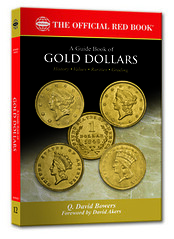 A Guide Book of Gold Dollars is the latest
entry in Whitman Publishings Bowers Series of numismatic references. It
debuted at the Whitman Coin and Collectibles Atlanta Expo in
August.
A Guide Book of Gold Dollars is the latest
entry in Whitman Publishings Bowers Series of numismatic references. It
debuted at the Whitman Coin and Collectibles Atlanta Expo in
August.United States gold dollars are a fascinating and highly collectible series. In A Guide Book of Gold Dollars, Q. David Bowersthe Dean of American Numismatics and the most prolific numismatic author of all timetells how to be a smart collector: how to evaluate quality, determine value, understand the market, and make good buys.
Along the way, he explains why, in all of American numismatics, the gold dollar possesses a special charm. Youll learn how the history of the nation shaped the coins design and productionhow the first gold dollars were made by a private coiner from gold mined in Georgia; why some felt only second-rate countries issued such small gold coins; what the public thought of the tiny, delicate, yet highly practical coins; and the effects of the Gold Rush, the Civil War, political controversy, monetary crises, and more on the coinage.
Bowers provides a wealth of information on each issue, including mintages, existing populations, grading information, values, auction records, and keys to collecting.
A historical backdrop of what was going on in America during each year, along with hundreds of full-color photographs, make this book a treat for anyone interested in our nations history.
By Q. David Bowers
Foreword by David W. Akers.
Full color; 6 x 9; softcover; 288 pages.
NEW BOOK: COINS: QUESTIONS & ANSWERS (5TH EDITION) BY CLIFF MISHLER
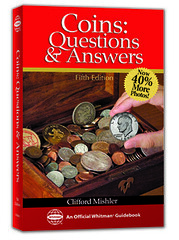 The fifth edition of Coins: Questions & Answers,
by Clifford Mishler, debuted at the Whitman Coin and Collectibles Atlanta
Expo in August.
The fifth edition of Coins: Questions & Answers,
by Clifford Mishler, debuted at the Whitman Coin and Collectibles Atlanta
Expo in August.A popular seller since it was first published nearly 45 years ago, the book provides detailed answers to hundreds of the most commonly asked questions about the world of money. It covers challenging, interesting subjects that have puzzled collectors for decades. The fifth edition includes more than 400 photographs (40% more than the fourth edition).
BOOK REVEW: BOIS DURCI, A NATURAL PLASTIC 1855-1927, BY GASTON VERMOSEN
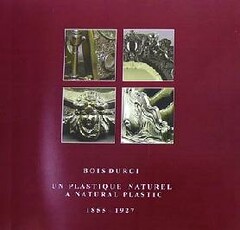 I recently acquired a new book on an old
subject. The name of the book is Bois Durci Un Plastique Naturel, A
Natural Plastic 1855-1927, by Gaston Vermosen. As you might surmise by
the title the book is bilingual, written in French and English. I do not
know of too many books written in this format, certainly not any
numismatic ones ("I could be mistaken, but never wrong" - who said
that?)
I recently acquired a new book on an old
subject. The name of the book is Bois Durci Un Plastique Naturel, A
Natural Plastic 1855-1927, by Gaston Vermosen. As you might surmise by
the title the book is bilingual, written in French and English. I do not
know of too many books written in this format, certainly not any
numismatic ones ("I could be mistaken, but never wrong" - who said
that?)For those of your readers who may not know what bois durci is, it literally means "hardened wood", a process of taking sawdust, albumen or animal blood and hardening in a mould to form the desired object.
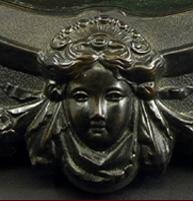 What numismatic connection is there? Various
medals and medallions were made this way after being introduced at the
1862 London Exhibition of the Works of Industry of All
Nations.
What numismatic connection is there? Various
medals and medallions were made this way after being introduced at the
1862 London Exhibition of the Works of Industry of All
Nations.The book is seventy-two pages in length, highlighted by fourteen pages dedicated to photos of the various manufactured objects de bois durci. It traces the historical beginnings, the many companies that evolved over time, their factories locations, production methods and their individual trade marks (mint marks?)

I found the book to be enlightening and one that should be in every numismatic library. It comes with its own CD and the author's promise to forward any additional updates. At the present time the only way to purchase the book is to e-mail the author at the following address gaston.vermosen@pandora.be The price is $45 USD.
The first edition is limited to 150 copies, and according to the Belgian author's web site, only 29 copies remain. The wide-format (21 x 21 cm) book has 72 pages of text and 14 color plates. The accompanying CD has a catalog with over 300 items illustrated, including over fifty plaques and medallions. The price is 22.50 EUR plus shipping. -Editor
To view the book's web site, see: http://users.telenet.be/plastics_collection/BOIS%20DURCI/index..htm
BOOK REVIEW: GOOD MONEY
 At the dawn of the industrial revolution as
workers left the fields and moved to industrial employment the demand for
a means of payment increased dramatically. Workers, once paid in kind,
needed to be paid in a medium they could use to buy the necessities of
life. Small-tender bank notes, however, were illegal and in Great Britain
the production of coin was monopolized by the Royal Mint which failed to
provide enough high quality coin to meet the demands of workers and
business. Silver coin, despite the efforts of Sir Isaac Newton, was
overvalued and fled the country. Gold was too expensive to make coins
suitable for workingmen and the Mint could not or would not produce
high-quality copper coins.
At the dawn of the industrial revolution as
workers left the fields and moved to industrial employment the demand for
a means of payment increased dramatically. Workers, once paid in kind,
needed to be paid in a medium they could use to buy the necessities of
life. Small-tender bank notes, however, were illegal and in Great Britain
the production of coin was monopolized by the Royal Mint which failed to
provide enough high quality coin to meet the demands of workers and
business. Silver coin, despite the efforts of Sir Isaac Newton, was
overvalued and fled the country. Gold was too expensive to make coins
suitable for workingmen and the Mint could not or would not produce
high-quality copper coins.Good Money is George Selgin's explanation of how enterprising button makers solved what Sargent and Velde called The Big Problem of Small Change thereby making the industrial revolution possible. Selgin is a monetary theorist so you might expect a dry account of monetary history but the mint-battle between Matthew Boulton, whom Wired once named the ultimate CEO, and copper-king Thomas Williams propels the story forward. If you can imagine, Good Money is something of a cross between Friedman and Schwartz's A Monetary History of the United States (although not as broad in scope) and a business epic like Barbarians at the Gate. I also liked how Selgin draws on newspapers, novels, limericks and tavern songs to illustrate the problems and events of the time. This bard was both a good economist (he has Gresham's Law!) and public choice scholar.
'Tis Gold buys Votes, or they'd have swarmed ere now,
Copper serves only for the meaner Sort of People
Copper never goes at Court
And since on Shilling can full Twelve Pence weight,
Silver is better in Germany
'Tis true the Vulgar seek it, What of that?
They are not Statesmen,-let the Vulgar wait.
The money problem influenced and was influenced by all of the major events of the day so Good Money is also an economic and political history of the industrial revolution. Here's an interesting tidbit. Company stores were not so much a way for firms to rip off employees (why not just pay them less?) but were rather a means of economizing on coin. Selgin shows how the shortage of coin sheds light on a number of other otherwise peculiar business practices.
What lessons can be drawn from the history of private coinage? Private money circulated only if it was voluntarily accepted as a means payment. Thus the primary problem faced by private firms was how to create trust and credibility. To encourage circulation, for example, issuers promised to redeem their tokens in gold (which the Royal Mint did not). In turn, the promise to redeem gave producers an incentive to make their coins difficult to counterfeit, which they did by making the coins beautiful - numismatists will appreciate the full-color illustrations of the private coinage produced by Boulton and his rivals - as well as technologically advanced.
Today, the big problem of small change is no longer such a big problem, although shortages of wanted coin continue to occur sporadically around the world (e.g. here and here) as well as surpluses of unwanted coin. Nevertheless, the basic problems of private coinage were trust and credibility. Modern issuers of digital cash face the same problems and thus Selgin's history is a valuable reminder about the scope and potential of alternative monetary institutions.
Full Disclosure: I was enthusiastic about Good Money when I read it in manuscript which is why it is published by the University of Michigan Press and co-published by the Independent Institute where I am director of research.
To read the complete article, see: Good Money (http://www.marginalrevolution.com/marginalrevolution
/2008/09/good-money.html)
BOOK UPDATE: EARLY UNITED STATES QUARTERS 1796 - 1838 BY STEVE TOMPKINS
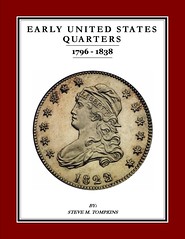 I just wanted to again thank everyone who
pre-purchased my new book EARLY UNITED STATES QUARTERS 1796 - 1838,
and say thanks for your patience in waiting to receive it! All of the
pre-orders have now been shipped and if you still have not received it
yet, it should be showing up any day. Please feel free to e-mail me if you
have any questions once you have had a chance to look through it. My
address is SMT115@aol.com earlyusquarters.com
I just wanted to again thank everyone who
pre-purchased my new book EARLY UNITED STATES QUARTERS 1796 - 1838,
and say thanks for your patience in waiting to receive it! All of the
pre-orders have now been shipped and if you still have not received it
yet, it should be showing up any day. Please feel free to e-mail me if you
have any questions once you have had a chance to look through it. My
address is SMT115@aol.com earlyusquarters.com I have added an errata page listing any errors that I have found in the book that was missed in editing, if anyone finds others please let me know and I will add them to the list. There is also a page listing "New Discoveries" for items that were found after the book was sent to the printer.
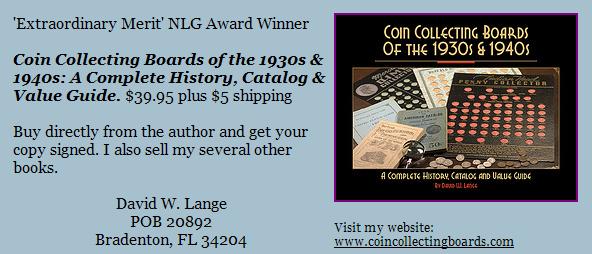
NOTE: David Lange writes:
HAL BIRT, JR., AUTHOR OF ARIZONA TOKENS AND SCRIP
Alan V. Weinberg writes:Hal Birt's book was titled Arizona Tokens and Scrip. It was published in 1990 and it is still the "bible" on Arizona trade tokens, although the Stack's Ford sale and the Schingoethe catalogs are now the bibles on Arizona scrip.
DR. CHARLES RADFORD STEARNS 1940 - 2008
Mack Martin writes:
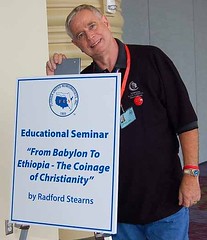 Dr. Charles Radford Stearns began his eternal
life with Christ Sunday, August 31, 2008 after experiencing all he could
during the time God gave him on earth.
Dr. Charles Radford Stearns began his eternal
life with Christ Sunday, August 31, 2008 after experiencing all he could
during the time God gave him on earth.He was born in Evanston, Illinois on October 12, 1940 to George Radford and Elisabeth D. Stearns and is survived by his wife of 42 years Mary Lucy (Franzman), his children Katherine Radford Stearns, Kristine Radford Lively (Ty), Thomas Radford Stearns and Ana Silva
After attending Notre Dame University he graduated from the Chicago College of Dental Surgery (Loyola) in 1967) to serve as an officer in the United States Navy in Albany, GA from 1967-1969. Dr. Stearns practiced general dentistry in Winder, GA but assembled the perfect staff in Lilburn, GA where he worked until his retirement in 2006.
Adventure travel, scuba diving, numismatics, underwater and wildlife photography and the Georgia Aquarium were just a few of his interests. His most significant trait was unbridled enthusiasm for anything he embraced, in his later years being the Leukemia and Lymphoma Society and the Lilburn Relay for Life.
In numismatics he was a long term member of ANA and was serving on the board of Governors. He was a speaker at conventions on several topics and as a collector, displayed exhibits and won the Howland Wood award. He played a large part in getting the book State of Georgia Treasury Notes, Certificates and Bonds completed and opened the door to many new collectors and exhibitors.
He will be missed greatly by those whose lives he touched. Let us remember that we need not mourn when great men as these are lost, but rather celebrate that they had lived among us.
Bob Rhue writes:
He was always active and contributing & sharing his passion for our hobby. He recently ran and was elected to the ANA Board, and had a lot of sound ideas to help dig the ANA out of its current mess.
He was proud of his wife and children. Just a wonderful, generous human being, and a friend whom Im proud to have known & whom Ill miss dearly. Thank you Rad for all you did to better our world.
John and Nancy Wilson write:
He was a great collector of Georgia Colonial Paper Money winning the ANA Howland Wood Best in Show Award. Besides collecting Georgia Colonial Paper Money, he also was a collector of Russian Money. Dr. Stearns not only exhibited at the ANA, but many other conventions around the country including CSNS and FUN. He was General Chairman for the 1987 American Numismatic Association (ANA) Convention in Atlanta, GA., where he received the ANA Goodfellows Award. This award is given to the ANA General Chairmen.
He also served at various ANA Conventions as Assistant General Chair, Educational Forum Chair and Exhibit Chair. He has served on the ANA Audit Committee. During this current term, he was Co-Chair of the Educational Committee. He has been on Numismatic Theater programs for the ANA, FUN, CSNS and many others. Besides these achievements, Dr. Radford Stearns has served in many capacities for the Georgia Numismatic Association and Blue Ridge Numismatic Association. He was appointed by President Gerald Ford to the United States Assay Commission.
Dr. Radford Stearns received many honors from the numismatic community that he was so dedicated to and loved so much. In 2004, he received the ANA Glenn Smedley Award and in 1995 two Presidents Awards. The coveted Numismatic News Ambassador Award was bestowed on him in 1988.
This great Numismatist, Doctor and family man has left a mark on everyone who has crossed his path. He will be in the memory of everyone who knew him. His work and accomplishments in the hobby and professionally will never be forgotten. All of our prayers and thoughts to his wife Mary Lu and the family. On behalf of numismatists everywhere, Rad, you will be missed but never forgotten.
TODAY'S QUIZ: TWO AMERICAN NUMISMATISTS AND A CANDIDATE'S LUCKY COINS
Who are these famous American numismatists? HINT: the second one died 100 years ago today. -Editor

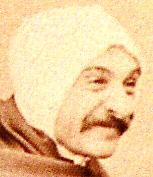
Dick Johnson writes:
THE BOOK BAZARRE
STAR STAMPS ON PAPER MONEY: MODERN CHOP MARKS
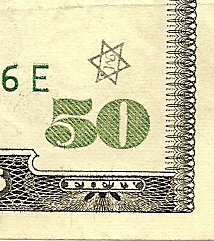 Tom DeLorey writes
Tom DeLorey writes
Joe Boling writes:
ON PHARMACIST-NUMISMATISTS
- Alden Scott Boyer
- Robert Coulton Davis
- Lewis Feuchtwanger
- George Francis Heath
- Henry H. Leiter
- William Elliot Woodward
David Gladfelter and Joe Boling both suggested Byron Johnson. He isn't in Pete's American Numismatic Biographies. Should he be? I asked Joe Boling for more background on Byron and he writes:
From reading the bio for Byron, I see that another numispharmacist was B. F. Miles.
Showoff John N. Lupia III writes:
- Robert Coulton Davis (1813-1888),
- Georg(e) Ludwig Ulex (d. 1883)
- William Forrester Dunham (1857-1936) ANA member no. 361
- Isaac Hands Gibbs, charter member of the ANS in 1858.
- Isaac John Greenwood, resident member of the ANS since January 12, 1859.
- William Elliot Woodward, coin dealer
- Harlow Elliot Woodward (1851-), son of William Elliot Woodward, who was not only a druggist in Boston but continued his father's business trading as W. E. Woodward Company, at 40 Bromfield Street, Boston, Massachusetts until about 1895.
- Alfred Bower Taylor(1824-1898), 1015 Chestnut Street, Philadelphia. An apothecary who manufactured bottled perfumes and toilet waters. He was a founder and served as the recording Secretary of the Numismatic and Antiquarian Society of Philadelphia.
- Dr. S. J. Caswell, MD (1847-), 616 George Street, Rockford, Illinois. ANA member no. 417
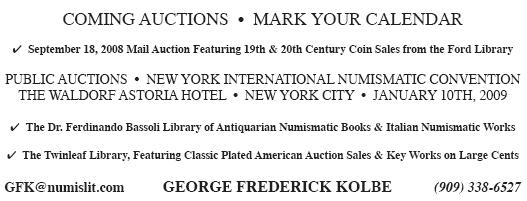
NEW TWIST ON COIN REEDING TECHNOLOGY: DIAGONAL REEDS
Timothy Grat of Moffat & Co. writes: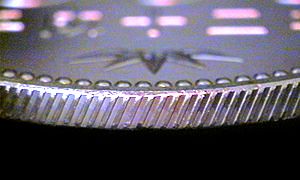 However, in direct reference to his comment,
the Japan Mint has released a 500 yen nickel-brass coin that is produced
using helical reeding. This diagonally oriented reeding is contained in
the collar which forms the coin edge upon striking. The ejection of this
coin requires a new advance in coin press technology which allows the
coining collar to rotate as the die pushes the coin out of the collar.
However, in direct reference to his comment,
the Japan Mint has released a 500 yen nickel-brass coin that is produced
using helical reeding. This diagonally oriented reeding is contained in
the collar which forms the coin edge upon striking. The ejection of this
coin requires a new advance in coin press technology which allows the
coining collar to rotate as the die pushes the coin out of the collar.
One must remember to visualize the coin that is struck is locked into the devices of the die and this in turn (pun intended) serves as the drive dog for removing the coin.
I realize that the term drive dog may be unknown to many of your readers - it is a machine tool term. A drive dog is a device that transfers rotary movement of the machine to the workpiece, in this case the rotary movement of the ratcheting ejection to the coin. If the face of the anvil die were blank, there would be no tooth to transfer the rotation to the finished coin.
Dick Johnson writes:
Timothy Grat responded:
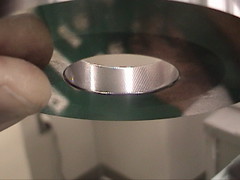 Here's an image that shows the collar itself.
This image was taken by Sean Moffatt at his visit to the Japanese Mint
during the 22nd Mint Directors Conference in Osaka.
Here's an image that shows the collar itself.
This image was taken by Sean Moffatt at his visit to the Japanese Mint
during the 22nd Mint Directors Conference in Osaka. Dick Johnson adds:
MORE ON COIN EDGE PHOTOGRAPHY
The first and foremost is the late Russ Logan. Russ was always a proponent for looking at the "third" side of the coin. Russ was so enamored with this part of the coin that he designed and developed a specially prepared edge "mirror" which his company built. He determined the proper angle for the surface and had it ground to this angle then polished to a mirror like surface. Development of these edge mirrors was described in his paper "The Third Die: A Different Look" appearing in America's Silver Coinage 1794-1891 presented at the 1986 ANS Coinage of the Americas Conference.
John McCloskey has also been counting reeds on coins for many years and has published much information in the Gobrecht Journal for many different denominations and different years found in the Seated coinage. These counts can be used to distinguish specific collar dies used, which can aid in detecting counterfeits and those with mint marks added to create rare coins.
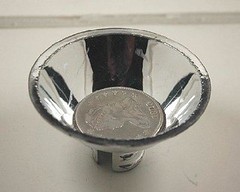 For those not fortunate enough to own one of
these edge mirrors, the simplest and easiest way to count the reeded edge
of a coin is the one described by Bill Bugert in the last issue. However,
counting the reeds is much easier if you put the coin in this reflector
and shoot a picture using a copy stand and a digital camera. Once you have
taken the picture and downloaded it to a computer, it can be cropped and
resized to something slightly under 8 1/2 X 11, then printed out on any
inkjet or laser printer.
For those not fortunate enough to own one of
these edge mirrors, the simplest and easiest way to count the reeded edge
of a coin is the one described by Bill Bugert in the last issue. However,
counting the reeds is much easier if you put the coin in this reflector
and shoot a picture using a copy stand and a digital camera. Once you have
taken the picture and downloaded it to a computer, it can be cropped and
resized to something slightly under 8 1/2 X 11, then printed out on any
inkjet or laser printer. You can then easily mark the page starting at any reed, count any direction, and mark every 10th reed. After completing the full circumference of the coin then count how many marks you have and add any leftover reed under ten on the last place you counted. I used this device to count the reeded edges on all die marriages of the Bust Quarters for my new book on that series.
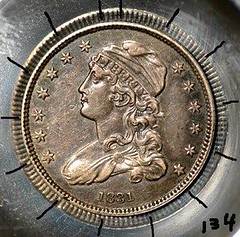 One thing you need to keep in mind is that the
flashlight reflector needs to be at the proper angle for the reeds to be
shown well in the photograph. A larger, wider lens will not work as well
as one about 2" in diameter. As most of these are made out of plastic and
just chrome-plated to create the mirrored surface, they are easily
scratched and after repeated use need to be replaced with a new one.
One thing you need to keep in mind is that the
flashlight reflector needs to be at the proper angle for the reeds to be
shown well in the photograph. A larger, wider lens will not work as well
as one about 2" in diameter. As most of these are made out of plastic and
just chrome-plated to create the mirrored surface, they are easily
scratched and after repeated use need to be replaced with a new one.
Also, make sure that the reflector you choose has a smooth surface, as many cheap flashlight reflectors are now being made with multifaceted surfaces which can not be used for this purpose. I get the ones I use at the local Dollar Store, for the large sum of...$1! (Who says all things related to numismatics have to be expensive?)
TRANSLATION FOR 2004 ATHENS OLYMPICS GOLD MEDAL
Last week Leon Worden asked: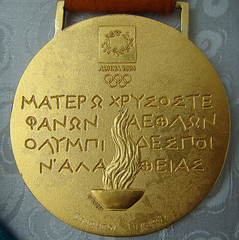 Can anyone translate the inscription on this
gold medal from Athens 2004? It belongs to Olympic home run record-holder
Crystl Bustos (USA Softball, 2000-gold, 2004-gold, 2008-silver), and she'd
like to know what it says.
Can anyone translate the inscription on this
gold medal from Athens 2004? It belongs to Olympic home run record-holder
Crystl Bustos (USA Softball, 2000-gold, 2004-gold, 2008-silver), and she'd
like to know what it says. Franois Velde of the Federal Reserve Bank of Chicago writes:
(most of the individual words are recognizable: mater=mother, chrusos=gold, stephanos=crown, aethlon has given us athlete, despoina is the same root as despot.)
MORE ON THE CHARLOTTE MEDAL PEDIGREE
Colin Pitchfork, President of the Australian Numismatic Society and Numismatic Consultant to Noble Numismatics forwarded the full text and illustrations of the medal from the recent Noble Sale. Many thanks! Here's an excerpt which includes a partial pedigree. -Editor
Ex The Marquess of Milford Haven, A.H.F. Baldwin and (Spink Australia Sale 6 [lot 422]) John J. Ford Collections. The `Charlotte' was built on the Thames in 1784. Her length was 105 feet, the maximum breadth between her wales was about 28 feet 2 inches, and her tonnage 38 tons. The ship featured two decks and three masts, but had no embellishments such as a figurehead or galleries, and contemporary records generally describe her as `square-sterned'.
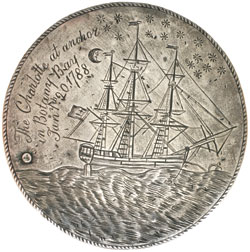

Christopher Eimer writes"
What was not mentioned in the catalogue is that the medal was published in 1919 in the first volume of the Marquess of Milford Haven's collection of naval medals, as No. 40 on pages 463, and on 465, where it is illustrated.
I trust that this finds you well and add my congratulations and praise for the work that you are doing on the E-Sylum.
TOM KAYS ON COLONIAL POCKET CHANGE
Ray Williams writes:Even if you don't collect colonial coins, most of us have an interest in our colonial history and can still enjoy this work.
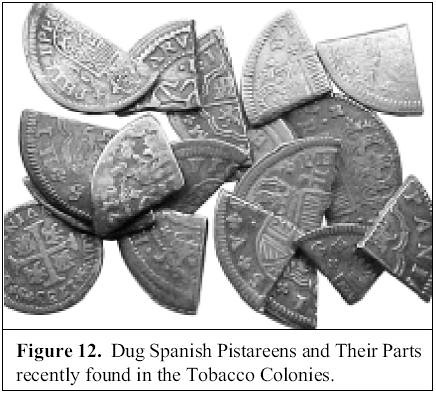
To read the complete article, see: When Cross Pistareens Cut Their Way Through the Tobacco Colonies (http://www.numismatics.org/cnl/Pistareens.pdf)
DICK JOHNSON ON ELECTROTYPES
Dick Johnson submitted this analysis of Jonathan's pieces, which includes a detailed description of the electrotype process. -Editor
Jonathan was particularly concerned about the wax coating on this piece. He said "I've shown these to several people, and nobody seems to know what to make of them." This is understandable. Electroforming, the electrolysis process, and even electrotypes are one of the least understood concepts of all numismatics. This is why I have joined with numismatist John Kraljevich in the preparation of a monograph on the subject, Electrogalvanic Casting In Numismatics. This has been mentioned previously in E-Sylum (vol 9, no 44, art 19, October 29, 2006).
This was mentioned prior to the publication of one of the few (and best!) articles on the subject. Red Book guru Kenneth Bressett wrote "The Nature and Use of Electrotype Reproductions" which appeared in the now defunct ANA Journal, spring issue 2007. Well worth obtaining that issue for reading that article alone.
An electrogalvanic mold is the pattern for casting electrotypes or galvanos. The pattern can be most any composition. The U.S. Mint was using iron in the 1850s; the British Royal Mint was using iron as late as 1886. But the pattern can be plaster, any other metal, or even carved wood (the later has to be specially treated to close all the tiny pores in the wood). A wax pattern is usually cast in plaster before it is used in the electrogalvanic process.
The pattern must be specially prepared: (1) the surface to be reproduced is coated with bronze power to make it electrically conductive -- this also acts as a release agent to remove the casting afterwards; (2) it is wired, two copper wires are attached to the pattern's surface to carry the electric current to a bus bar above the tank where the electrolysis takes place, these also support the pattern and its galvanic casting while it is in the tank; and (3) the area where no deposition is to take place is coated with wax, this is a stop-off (the British call this a resist).
The wax on Jonathan's electroform is this resistant material still intact. It covers the entire back, and the portion of the front, the flange, where no metal is to be deposited. If this were not done the metal would deposit on both sides, all around and entomb the desired electroform.
The wired and prepared pattern is immersed in an electrolyte solution in the tank. This solution is slightly acidic but also contains cyanide. Electrotypers have experimented for decades to replace the deadly cyanide, but found it is best to use in electrolysis. The solution must also contain ions of the metal to be deposited. Most metals can be electroformed. In numismatics it is the same as coinage metals, gold, silver, copper. The process is the same as goldplating, silverplating, copperplating. (Other metals are plated in the jewelry field, or even chromium plating in industry.)
A tank large enough to contain the suspended pattern contains the electrolyte solution. It also must have anodes present. If you are creating a copper electrotype, you must have several pure copper anodes suspended in the solution as well. Separate tanks for each metal. The anodes are sacrificial -- they wear away like a bar of soap -- ions of the copper in the anode pass into the solution and deposit on the pattern's treated surface, this is the cathode, when the electric current is turned on.
The current must be a low voltage direct current and must form a complete circuit. A rectifier converts AC current to DC and is wired to bars from which the anodes are suspended. The current passes into the anodes then into the solution, onto the cathode pattern, up the copper wires to the bus bar and back to the rectifier. Circuit completed.
It is fun to watch gold or silverplating. It changes the color of the anodic metal in about 15 seconds. But usually it requires about three days to deposit enough metal, say a 1/16th inch, to give the electroform enough strength so it won't malform. This form is also called a galvano. After that time the ensemble of pattern and electroform are removed from the tank.
They are separated. If any opening is found a screwdriver is inserted between the mold and the cast galvano. It is pried open a little more. The electrotypers' trick of the trade is applied. Compressed air is blown into this opening and the two snap apart.
Jonathan's electroform is negative. As a negative mold it makes a positive cast.. (Casting always reverses polarity.) His photo shows a hanger. This was not used in the electrolysis process; it was intended to hang on a wall. How much more realistic to have the original two copper wires intact.
If Jonathan can prove the provenance of this piece back to Pinches, it may have been the original one Pinches used in 1849 to make the first Waterloo Medals. However, once you have one of these medals anyone with electroforming equipment and the required skill could copy it by creating the pattern for casting these medals anew. Unlike foundry casts, however, subsequent electroformed castings do not shrink, they are the exact same size as the original, so size is not a diagnostic.
Operating a successful electrolysis is not easy. There are a many variables, chemical composition, pH, temperature, placement of the pattern in relation to the anodes, the electric circuit, the ionic balance. It takes considerable skill. That is why you will not find many electroformed copies.
Possibly Jonathan's pattern could have been made in the United States. It could have been made by one of the New England silverware firms (1850s) or by New York City electrotyper Samuel H. Black as early as 1859. Or by a specialized electroforming firm as early as 1884. We have a list of a dozen American electrotypers and are compiling the known electrotypes they made.
The most important thing you should remember about electroforming -- it replicates minute detail. In comparison with other methods of making numismatic items: foundry casting reproduces detail down to 1/100 of an inch, die striking reproduces detail down to 1/1000th of an inch, but electroforming reproduces detail down to the width of an atom!
Medalmakers have a saying about this: "If it is in the model, it is in the medal." Here are some highlights in the history of electroforming:
- In 1791 Italian Luigi Galvani (1737-1798), for whom "galvano" is named after, first observed electric current.
- In 1800 another Italian, Alessandro Volta (1745-1827) -- "volt" is named after him -- created the first voltaic pile, a battery. Batteries were the source of the electric current until Thomas Edison developed electric generation.
- In 1805 a third Italian, Luigi Brugnatelli performed the first electroplating, on two medals!
- In 1837 a German Moritz Herman Jacobi (1801-1874) first developed the electrolysis process which he called "galvanoplasty."
- In 1840 two British cousins George and Henry Elkington learned of Jacobi's process and patented it in England for the manufacture of silverware.
- In 1844 Scovill Manufacturing in Waterbury is first to use electrolysis in America.
- In 1847 the Rogers Brothers imported Elkington's process for
sillverplating utensils in America and created their famed 1847
trademark.
- In 1849 the world's most famous electrotype medal was made for the 1815 Battle of Waterloo after medallist Benedetto Pistrucci (1784-1855) had taken three decades to model it. Pinches had to electrolytically cast it because it was too large to strike with a pair of dies.
- In 1851 William E. DuBois (1810-1881) begins using electrolysis at the U.S. Mint according to Kenneth Bressett.
- In 1860 DuBois replicated the 1804 dollar by electrolysis.
Jonathan Brecher adds:
I wish I could prove the provenance back to Pinches. Unfortunately, this came from an estate sale. Whatever the previous owner knew, it's been lost.
I'll definitely try to track down a copy of that ANA Journal. I'm not actually collecting electrotypes, but I've picked up a few that I like, and I definitely don't know as much as I could. Thanks, Dick!
Dick Johnson adds:
If you would like to see this process in action -- or if you would like to have a positive made from your mold -- I recommend you bring your mold to the following firm to have this work done, they are the America's most expert medallic electrotypers:
Greco Industries, Inc.
Ricky Greco, VP
Francis J. Clarke Industrial Park
14 Trowbridge Drive
Bethel, CT 06801
Phone: (203) 798-7804
Email: greco86@aol.co
This firm is in a brand new $3 million plant. It was founded by Hugo Greco, former head of the finishing department at Medallic Art Co in New York City. He just celebrated his 50th year in the field. The Greco family brings a great deal of Italian craftsmanship to their work.
As I have mentioned in a recent article in MCA Advisor, foundry casting can reproduce detail down to 1/100th of an inch, die striking can reproduce detail down to 1/1000th of an inch, but electrogalvanic casting can reproduce detail to the width of an atom!! It is far more detailed.

To view all of Jonathan's photos as a slide show, see: Pistrucci Waterloo Medal electrotypes (http://www.flickr.com/photos/coinbooks/sets/72157606974566395/show/)
AN EARLY U.S COIN WITH THE POLHEMUS COUNTERSTAMP
Steve M. Tompkins writes: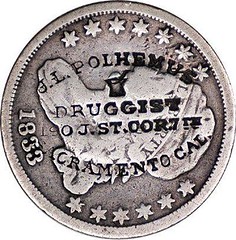
ON PAYMENTS IN GOLD
Franois Velde of the Federal Reserve Bank of Chicago writes:
To read the complete article, see: 1912 Gold Coin Lease Payment Term is Enforceable, 6th Circuit Rules (http://www.abajournal.com/news/1912_gold_coin_lease_payment
_term_is_enforceable_6th_circuit_rules/)
ON PAYMENTS IN PENNIES
Joe Boling writes:
Franois Velde of the Federal Reserve Bank of Chicago writes:
I don't understand the court case, since a fine is as a debt. In payment of goods and services, there is no debt, and legal tender does not apply: see the Treasury's FAQ at FAQs: Currency: Legal Tender Status . (http://www.ustreas.gov/education/faq/currency/legal-tender.html#q1)
I asked David Ganz for comment and he forwarded this:
Theres an amplification on the Treasury Departments web site. They ask the question a different way, but point to the same answers. ON the web site, the party says I thought that United States currency was legal tender for all debts. Some businesses or governmental agencies say that they will only accept checks, money orders or credit cards as payment, and others will only accept currency notes in denominations of $20 or smaller. Isn't this illegal?
Responding, Treasury says The pertinent portion of law that applies to your question is the Coinage Act of 1965, specifically Section 31 U.S.C. 5103, entitled "Legal tender," which states: "United States coins and currency (including Federal reserve notes and circulating notes of Federal reserve banks and national banks) are legal tender for all debts, public charges, taxes, and dues."
They go on to explain that This statute means that all United States money as identified above are a valid and legal offer of payment for debts when tendered to a creditor. There is, however, no Federal statute mandating that a private business, a person or an organization must accept currency or coins as for payment for goods and/or services.
Summarizing its position, Treasury goes on to say that Private businesses are free to develop their own policies on whether or not to accept cash unless there is a State law which says otherwise. For example, a bus line may prohibit payment of fares in pennies or dollar bills. In addition, movie theaters, convenience stores and gas stations may refuse to accept large denomination currency (usually notes above $20) as a matter of policy.
Actually, the citations to federal statutory sources are correct, and so are the examples cited because they are examples of real-life cases that have been decided for the propositions stated. But they ignore the history of what legal tender means, what in fact legal tender really means, and why laws about them were created in the first place.
There are two constitutional issues that are useful to discuss what the words mean. First, is Article I, Section 8 of the Constitution, which provides "The Congress shall have Power ... To coin Money, regulate the Value thereof, and of foreign Coin, and fix the Standard of Weights and Measures...."
Next is from Article I, section 10, which reads, "No state shall ... coin Money' emit bills of Credit; make any Thing but gold and silver Coin a Tender in Payment of Debts...." Courts have consistently held that neither of these provisions of the Constitution renders the country's current money system unconstitutional, staring with the Legal Tender Cases in 1884.
Those cases involved the ultimate political gamble: creation of paper currency at the height of the Civil War, designed to fund the effort. Its inventor: Salmon P. Chase, Secretary of the Treasury. When accomplished, the federal government reportedly had three days in funding in its vaults; thereafter, it printed what it needed.
Legal tender ultimately is the power of compulsion. It means that the government can require you, willingly or not, to accept a type of money that is tendered. Thats why state-authorized private banknotes were an ultimate failure and sold at discounted prices that were disparate.
Over the years, there have been many challenges to what legal tender means; few recall that prior to 1857, foreign coins circulated freely in the United States. The act of Feb. 21, 1857, (ch. 56, 11 Stat. 163 ) determined that the legal tender of the Spanish pillar dollar continued but for other foreign coins, legal tender status was denied.
To read the complete article, see: Court refuses payment in pennies (http://www.wkyc.com/print.aspx?storyid=95234)
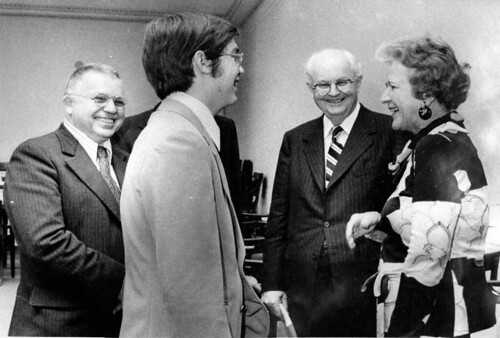
ARTICLE EXPLORES HISPANIC SOCIETY PLANS TO SELL HISTORIC COIN COLLECTION
This week The Art Newspaper published an article on the collection, reporting speculation that the Spanish government may be interested in bidding. One reader believes that the ANS was "hoodwinked" out of the $30-40 million collection. -Editor
The valuable collection consists of coins minted in Spain, its dependencies, and the powers that controlled Spain from the 5th century BC until the 20th century. They were deposited at ANS by the organisations president and patron Archer Huntington (1870-1955), who was also founder of the Hispanic Society. Ute Wartenberg Kagan, executive director of ANS, estimates that the collection may be worth $30m-$40m, with the Roman gold and silver and a rare 50 excelentes of Ferdinand V and Isabellathe worlds largest struck-gold coinalone worth perhaps $15m$20m. Sothebys and the London-based coin firm Morton & Eden began creating an inventory and appraising the Roman, Visigoth and Islamic gold coins last month.
A Hispanic Society spokesman says that the trustees have decided to explore a deaccession [but] no decision has been made on going forward. But The Art Newspaper has seen a copy of a letter that the Hispanic Societys director Mitchell Codding sent to Ms Kagan on 25 January 2008 in which he informs her that the board of trustees adopted a resolution to deaccession the loan collection with the assistance of Sothebys International.
Title to the coins became an issue in early 2007 when the Hispanic Society drew up a modern loan agreement. We signed it in April 2007 and in July received a letter cancelling it and saying we want our coins back, says Ms Kagan, calling the revised document a set-up intended to eliminate any questions of ownership related to the original informal deed of loan. In February 2008, two weeks after the loan expired, the Hispanic Society filed a lawsuit in Supreme Court of New York County demanding the return of the coins, and in April won a judgement that the Hispanic Society alone owned the coins and that ANS must return them.
Sothebys vice-chairman David Redden helped convince the judge that ANS should make available not only the photographic record that Huntington provided for most of the coins, but also the computer database that ANS subsequently created. We were told to hand over the entire record and that we had no copyright on this material. We basically gave them a sales catalogue as well as the coins, Ms Kagan says.
We will submit a formal letter to the New York attorney general objecting to the sale, she says, referring to the state official who oversees charities. We want to point out the violation of Huntingtons very clear intent that nothing would be sold, she says. The Hispanic spokesman maintains that any sale would be done with full transparency and in compliance with the rules of the American Association of Museums and applicable laws of the State of New York.
The fear among scholars is that the historic Huntington collection will be broken up. Ms Kagan says ANS donors would not be able raise the funds to buy it, though she would particularly like to acquire the antique items that today cannot be obtained legally because of restrictive patrimony laws.
Some insiders believe the Spanish government may be interested in purchasing the collection en bloc. The Hispanic Society has cultivated close relations with Spain, and sought the governments financial assistance to move the museum and its holdings from upper Manhattan to a more accessible location in the city centre, but that support never materialised and last year the relocation was abandoned. We just want to preserve what can be preserved, she says, but I am pessimistic.
Web site reader Adrian Dunevein commented:
To read the complete article, see: Hispanic Society to sell historic coin collection? (http://www.theartnewspaper.com/article.asp?id=16116)
QUERY: PERSONALIZED "DOG TAGS" ENGRAVED ON COINS
Steve M. Tompkins writes:In the Love Token arena, there are many examples found that list items that might in actuality be hand-made Civil War dog tags. Sometimes this is only a name, sometimes actual dates are listed, presumably for when a soldier enlisted or when enlisted and when mustered out if two dates are listed. The ones that leave absolutely no doubt about their purpose actually list the battles that the soldier saw action in. I look forward to seeing what the authors have covered in this new work.
QUERY: BYRON REED
Mitch Ernst writes:- A eight-page self-covered booklet published for the dedication of the Byron Reed Collection Exhibit at the Western Heritage Museum, April 7, 1989. Present was "Dr. Richard G. Doty, Associate Curator of the National Numismatic Collection at the Smithsonian Institution."
- A one-sheet folded pamphlet c1988 published by the Western Heritage Museum
- A one-sheet folded pamphlet from 1988 published by the Western Heritage Museum
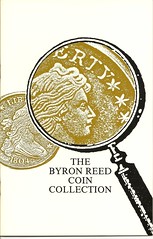
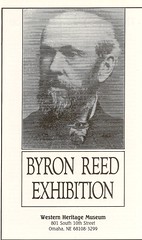
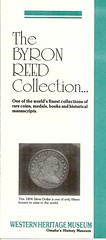
Going straight to the source, I asked Dick Doty, who was there for the exhibit opening. He writes:
I was involved with the collection on three occasions. I appraised it at the end of 1985 not sure how they contacted me, but they did and I went. Then there was the dedication of the new exhibit in May 1989, and a final trip out in early fall 1996 or 1997 to advise them on what to do next. Lawrence Lee was their curator at that point.
The eternal problem with that collection was an ongoing tug-of-war between the Mayors office and various other branches of the government. The first time I saw it, it had superb US stuff, including both varieties of 1829 5$, in proof; a stellar collection of German thalers, and, for what its worth, the best collection of Sutler tokens anywhere, incl. manufacturers samples. I always meant to get back out and work on the last, but never did.
Dr. Lawrence J. Lee of Lincoln, NE writes:
Mitch Ernest will be at the museum as our guest and I will tell him about the two, 3-ring notebooks I have of articles and commentary regarding Reed, his biography, his coins, various fights through the years to sell his collection, the selling of portions of his collection in 1996, the opening of the exhibit in 1998 and the ongoing trials and tribulations of the collection. I will also have a copy of the final report I submitted to the Omaha City Council in 2001, summarizing the collection and its holdings.
We won't get to see it on our tour as it is in a climate-controlled vault, but Reed's library of numismatic books and catalogs (said by Charles Davis in 2001 to be "the last 19th Century numismatic library") is still intact. The collection contains 183 pre-1891 numismatic books (many first editions, including Hickcox, Maris, Crosby, Dickeson, Slafter, Frossard, Doughty and Baker) and 237 auction catalogs (no Attinelli but virtually complete runs of Bangs & Co, Chapman Bros., etc., and almost all with "prices realized" marked in them). Reed's remaining working library also includes another 874 general works, 162 newspapers and over 1,380 documents.
We anticipate having a great time. It's a pity everyone can't be a member of the Lincoln Coin Club.
QUERY: WHAT IS A NUMISMATIC BIBLIOPHILE?
I'm a coin collector specializing in American Colonials. In the process of researching my hobby, I've accumulated many books. Most of the books I have, I purchased for their contents. But I do own an original Crosby and an original Maris, in addition to the modern reprints of each. Does that make me a bibliomaniac? ( I bet my wife thinks so!)
In my three china cabinets in the dining room, you can look through the glass doors and see no china, just numismatic books packed tightly. Does this make me a bibliomaniac? (It does make me a lucky man to have a wife this understanding!)
I don't collect books for their rarity or value. I do enjoy holding a nicely leather bound book in my hands but I also enjoy using a modern reprint where I can make notes in the borders. I value three books that are all Rarity 7 not because of their potential market value but because of the sentimental stories as to how they came into my possession. I guess I'm not quite a bibliomaniac but a coin collector that has a deep appreciation for his library.
While we're talking about appreciation of a library, I've questioned many friends about why collectors will spend hundreds and thousands on coins for their collections but will refuse to spend a relative pittance for books to enable them to enjoy these coins. It's mind boggling to think that a $50 or $100 book that will give years of enjoyment will go unpurchased. Not just books, but hobby publications and clubs are neglected too while the coin collector never knows what he's missing... Sometimes you can't even lead the horse to water!
OK readers, how would you fill in the blank? And is Ray a numismatic bibliophile, or not? -Editor
ARTICLE HIGHLIGHTS JOSEPH N. T. LEVICK'S MILITARY SERVICE
When Brigadier General Daniel Sickles decided to raise a brigade composed of Empire State (New York State) troops, he envisioned a brigade staffed by the finest officers available, officers who had already been tested in battle. With those qualities in mind, Sickles raised what was to become known as the Excelsior Brigade.
One of those selected was Joseph Napoleon Tricot Levick, a transplanted Louisianan of French ancestry. Having served as a private in Company H of the famed 7th New York State Militia for about 40 days, Levick sought to parley his militia experience into a commission. For although it was rapidly becoming a war of exacting brutality, it was just as quickly becoming a war of opportunities wherein a lowly former bookkeeper, such as Levick, could rise through the ranks.
On June 11, 1861, Levick was commissioned 2nd lieutenant of Company I of the 1st Regiment, Sickles' Brigade, later redesignated the 70th New York State Volunteer infantry a.k.a. the 1st Excelsior Regiment of the Excelsior Brigade. For almost two years, he would experience some of the most intense fighting of the war. Promoted on April 30, 1862 to first lieutenant, Levick would engage the enemy in his new rank five days later.
On May 5th, while Brigadier General Edwin Sumner sat idly with his command astride the Yorktown Road in front of Fort Magruder, near Williamsburg, Virginia, an impatient Brigadier General Joseph Hooker, commanding the 2nd Division of the Third Corps, sent his command forward to engage the Confederates entrenched in front of Fort Magruder. The 70th New York, along with the balance of Hooker's 1st Brigade, advanced vigorously to the task.
For about two hours Hooker's Division gave better than they got and actually captured almost all of the rifle pits in front of Fort Magruder. But finally, with no help in sight and fighting against twice their number, Hooker's Division grudgingly began to give ground. In the desperate hand-to-hand fighting of the rear action that followed the 1st Brigade's withdrawal, 1st lieutenant Levick was constantly in the thick of the fighting. Just as all seemed lost for the 1st Brigade, General Philip Kearney's Division of the Third Corps came to Hooker's aid and largely contributed to the victory the Union command would claim that day.
One day later, lieutenant Joseph Napoleon Tricot Levick was promoted on the field of battle to the brevet rank of captain for conspicuous gallantry during the previous day's battle
Jim Neiswinter adds:
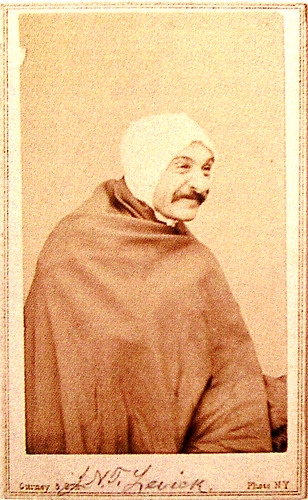 This explains why I could never find anything
about him in Philadelphia before 1855. I've been trying to find out what
the "N T" in "Joseph N. T. Levick" stood for since 1986. If he moved North
in the 1850s he probably had a pronounced southern accent. And he fought
for the North.
This explains why I could never find anything
about him in Philadelphia before 1855. I've been trying to find out what
the "N T" in "Joseph N. T. Levick" stood for since 1986. If he moved North
in the 1850s he probably had a pronounced southern accent. And he fought
for the North.There are 2 known pictures of Levick. The first is the one everyone has seen - with the bowler hat & Pince-nez glasses. The American Numismatic Society archivist, Joe Ciccone, told me he recently found an old photo album. Apparently the ANS asked for pictures of the members back in the late 1860s and put them in this album. The other picture is a strange one. If it didn't have Levick's name at the bottom you would be hard pressed to know that it's him.
I realized this morning when I saw today's date in the paper - Levick died 100 years ago today.
To read the original article, see: Four Yanks (http://findarticles.com/p/articles/mi_qa3905/is_200407/ai_n9455573)
ECONOMIC WOES HIT THE E-SYLUM: WELCOME TO THE E-SLUM
An E-Sylum subscriber writes:
1873-CC SILVER DOLLAR STAVES OFF HOME'S FORECLOSURE
The couple, who did not want to be identified, brought an old silver dollar to the Cash-4-Gold store on the corner of Ridge and Pearl in Parma.
Jim Matiach, owner of the business and president of Coin and Jewelry Buyers of America, examined the 1873-CC silver dollar and gave the homeowner the good news.
"We sat down and we were able to negotiate a price and he walked away with enough money to pay off some of his bills and hopefully be able to keep his house," says Matiach.
Depending on its precise condition, the 1873-CC Seated Liberty dollar can be worth tens of thousands of dollars. Only 2,300 were minted but only 40 to 60 are believed to still exist, with the others having been melted down.
Matiach says it is not unusual to find people searching their homes for old coins, especially today. The pile of coins on his counter, recently sold for cash, confirms his observation.
"I deal with this on a daily basis at this point. The economy is very slow right now. Metal is very high," Matiach tells Channel 3 News.
He says people are scouring their houses for silver, gold, old jewelry, silverware, and even old tea sets, a fine example of which was just sold by an older couple.
"People are losing their jobs," explains Matiach, "and the easiest way to get by and pay your bills right now is to go clean out your drawers. I mean we buy everything."
To read the complete article, see: Rare coin saves house from foreclosure (http://www.wkyc.com/news/news_article.aspx?storyid=96088)
A PRESIDENTIAL CANDIDATE'S LUCKY COINS
According to reporters following the campaign, McCain is quite superstitious, a throwback to his days as a Navy pilot. Supposedly, he also owns lucky feathers, shoes and sweaters, plus a laminated four-leafed clover he carries in his wallet.
Last April, The Washington Times reported McCain's lucky lucre consists of a certain quarter, nickel and penny, either given to him by admirers or found by the senator himself.
But, as any seasoned coin picker-upper will attest, they all were heads-up when found.
According to folklore, a coin will not impart good fortune to the finder if it is tails-up. It has to be heads, or it isn't touched.
Surely McCain isn't alone. People can dismiss superstitions all they want, but deep down inside, just about everybody has some quirk, custom or talisman they believe in.
To read the complete article, see: Venable: A different type of 'change' (http://www5.knoxnews.com/news/2008/sep/04/a-different-type-of-change/)
FEATURED WEB PAGE: 1842 BOOK ON CHINESE CASH COINS
This week's featured web page from Luke Roberts' site on Japanese coinage.From the web page:
... Kokin kousei, Shinsen zeni kagami (Corrected Against Past and Current Records, A New Selected Mirror of Cash Coins). It was published in three parts but bound together here (21.7cmX15.8cm), perhaps by the purchaser. The colophon of part one states that it was published in the summer of 1842 by Nakamuraya Touji. He was a store owner dealing in old coins and his store was in Kyoto

http://www.history.ucsb.edu/faculty/roberts
/coins/Zenikagami/
